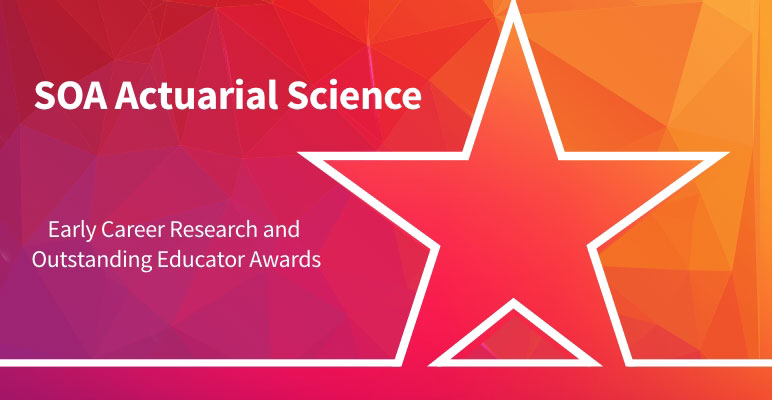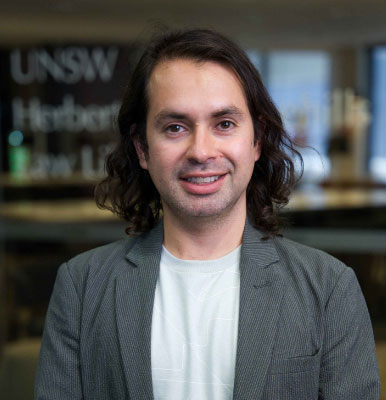An Interview with Andrés Villegas
By Expanding Horizons Editors
Expanding Horizons, June 2025

Expanding Horizons recently had the opportunity to interview Andrés Villegas, the winner of the Society of Actuaries’ (SOA’s) fourth Actuarial Science Early Career Award.

Expanding Horizons (EH): Congratulations on winning the Actuarial Science Early Career Award. Can you tell us about your background?
Andrés Villegas (AV): Thank you! I was extremely happy to receive this award.
I grew up in Colombia, and in school, I always enjoyed math and how it could be applied to solve real-life problems. For my bachelor’s degree, I studied mathematical engineering at Universidad EAFIT in Medellín. After that, at the same time as I was working as an actuarial analyst at a Colombian insurer, I completed a master’s degree in industrial engineering at Universidad de los Andes in Bogotá.
In 2010, I was fortunate to move to London to pursue a Ph.D. in actuarial science at Bayes Business School. Then in 2015, I moved to Australia for a postdoctoral position, and I’ve been living in Sydney ever since. I’m now an associate professor in Actuarial Studies at the University of New South Wales (UNSW) Sydney in Australia, working at one of the largest actuarial science departments in the world.
EH: How did you get into the profession?
AV: It’s perhaps not surprising that I became an actuarial academic. My dad was a library science professor at the state university in Medellín, and my mum worked her whole life at a large Colombian insurance company. So I grew up between a university and an insurance company—what else could come out of that but an actuarial science academic?
More concretely, I studied applied math as an undergraduate, and during an internship at a Colombian insurer, I was asked to conduct a mortality experience analysis for the life annuity portfolio. That experience hooked me, and here I am almost 20 years later, doing research on longevity risk and mortality modeling, and teaching survival analysis to actuarial students.
EH: Did you receive any support that has substantially helped you in your early career?
AV: I’ve been fortunate to have had many mentors throughout my career. Two who played a very special role were Luis Gutierrez and Armando Zarruk, Colombian actuaries I worked with during my early days as an actuarial analyst. Their passion for the actuarial profession was contagious. They shared their experience of studying actuarial science in the US and encouraged me, showing me it was possible to go abroad and pursue an academic career.
I’m also incredibly grateful to Professor Steve Haberman and Professor Michael Sherris for taking me on as a Ph.D. student and postdoctoral researcher, and for all the academic opportunities they’ve given me to develop my research.
EH: What are your research topics?
AV: The primary goal of my research is to develop analytical techniques that help model human longevity and assess and manage the social and financial implications of population aging and increasing life expectancy. In particular, I work on developing analytical and computational tools for projecting mortality, aiming to equip demographers and actuaries with efficient and accurate tools to forecast mortality trends. I also conduct research to understand the drivers of mortality trends and disparities. Beyond mortality modeling, I explore longevity risk management through product innovation, such as longevity risk-sharing mechanisms.
EH: What are your most important academic achievements?
AV: Perhaps my most important academic contribution is the R package StMoMo. This package implements a unifying framework that encompasses many of the stochastic mortality projection models proposed in the actuarial and demographic literature. It’s widely used by students, researchers, insurers, consultants and regulators.
Interestingly, although StMoMo is my best-known contribution, it originated as a side project from an industry-funded project on longevity basis risk. We needed a quick way to test various stochastic mortality models, so we developed a unified codebase to implement different models efficiently. After that project, we decided to package it into an R package that others could easily use.
EH: Any personal philosophy regarding actuarial teaching?
AV: Actuarial science is a highly technical and quantitative discipline, and it’s easy to get swept away by mathematical details and lose sight of the broader context. As an educator, I believe my role goes beyond teaching the syllabus and technical content—it’s about fostering essential skills.
I aim to inspire my students to become adaptable graduates who can navigate rapid changes in society and professional practice, challenge assumptions, and understand the social and cultural implications of their professional decisions.
To support this, I bring in current professional developments, relevant readings and real-world examples from my research and industry engagement. I’m also committed to educating socially responsible professionals. While my courses are technically demanding, I make ethical issues and implications a core learning outcome.
EH: Do you have any advice for young actuaries and young researchers?
AV: Read widely and attend talks and conferences beyond your specific research area—both within and outside actuarial science. For example, I enjoy following research in demography and epidemiology, which brings new perspectives and methodologies to my own work.
Also, work hard but take breaks. Academia can be very competitive, and burnout is real. Sometimes the best way to find a breakthrough is to step away, enjoy life beyond academia and return to your work with a fresh mind. Research is a marathon, not a sprint.
EH: What challenges did you encounter as an actuarial researcher?
AV: One challenge is coping with the academic pressure to be productive and publish frequently while still tackling meaningful, high-impact problems. The best work often takes time, but in today’s academic environment, it can be difficult to prioritize quality over quantity.
EH: Why and how do you think the insurance industry should support academic actuarial research?
AV: Collaboration between academia and industry is essential. One of the reasons I was drawn to actuarial research was the opportunity to solve practical problems with real-world impact. Some of my proudest work has come from industry-funded projects.
Industry partners, often through actuarial associations like the SOA, present relevant questions that help drive focused, meaningful research. StMoMo, as I mentioned, emerged from this type of collaboration. These partnerships also ensure that academics stay current with industry trends, which enhances our teaching and better prepares our students for their careers.
EH: What do you see as the biggest challenge of the actuarial profession?
AV: One major challenge is expanding the reach of the profession to a broader and more diverse talent pool. In developed countries like Australia and the US, we must ensure students from disadvantaged backgrounds have access to the education, exposure and mentorship needed to consider actuarial science as a viable career path.
Globally, we need to increase the training of actuaries in developing countries. It’s a stark contrast: in Australia, over 500 high school graduates choose actuarial science annually, whereas Colombia has fewer than 300 qualified actuaries for a population almost twice the size of Australia’s. Actuarial skills could make a significant contribution in important areas like social security planning.
Similarly, actuarial academia still underrepresents scholars from the Global South and underexplores research relevant to the developing world. That’s why initiatives like the Actuarial Faculty Development Program (AFDP) led by ACTEX to strengthen actuarial teaching staff in low-middle-income countries and the UNDP-Milliman Global Actuarial Initiative (GAIN) are so important for broadening access and inclusion in the profession.
EH: What is your vision for the future of actuarial research?
AV: Actuaries are uniquely equipped to tackle key societal challenges, including the rise of artificial intelligence, climate risk and population aging. Our blend of statistical, mathematical, communication and business skills, along with a deep understanding of models and their implications, positions us to make broad contributions beyond traditional insurance fields.
I see actuarial research expanding its influence and helping to shape important public policy debates. For example, in aging societies, actuaries bring both demographic and financial expertise. Similarly, as we navigate the integration of artificial intelligence, actuaries can contribute critical insight into both technical implementation and ethical implications.
EH: Do you have any hobbies?
AV: Yes! I love playing sports—tennis, running and European handball (even though I’m only 5 feet, 2 inches tall). I’ve played handball since I was 10 years old, and I still play with the UNSW team. For me, it’s the perfect way to disconnect and blow off steam after a busy week.
Statements of fact and opinions expressed herein are those of the individual authors and are not necessarily those of the Society of Actuaries, the editors, or the respective authors’ employers.
Andrés Villegas, Ph.D., is an associate professor at the School of Risk and Actuarial Studies at UNSW Sydney. Andrés can be reached at a.villegas@unsw.edu.au.
